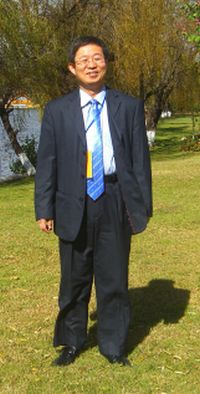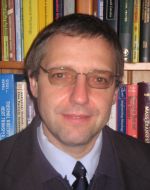Keynote Speakers
We are very pleased to have acquired the services of an excellent selection of keynote speakers for SEB'09. It is our aspiration that these speakers will give our delegates a view about technological and scientific activities, relating to sustainability in energy and buildings, taking place in various areas of the world.
The speakers and the titles of their talks are shown below.
Note that the list is incomplete at the moment and other speakers will be added over time.
Professor Ali Sayigh
Chairman of World Renewable Energy Congress, andDirector General of World Renewable Energy Network,
Brighton, UK
Renewable Energy and the Changing World
More details ...
Professor Yongqian Liu
North China Electric Power University,People's Republic of China
The Development of Wind Energy in China
More details ...
Professor Sture Holmberg
Royal Institute of Technology, Stockholm, SwedenSustainable Energy Solutions and Indoor Climate Conditions in Buildings
More details ...
Professor Bogdan Dlugogorski
Priority Research Centre for Energy, The University of Newcastle,
Australia
Assessment of Mineral Carbonation as an Option for Sequestering CO2 Emissions
from Coal Power Stations in the State of New South Wales in Australia
More details ...
Professor Eric Kennedy
Priority Research Centre for Energy, The University of Newcastle,
Australia
Development of a non-destructive process for treatment of fluorine-containing synthetic greenhouse gases
More details ...
Professor Ali Sayigh
Chairman of World Renewable Energy Congress, and
Director General of World Renewable Energy Network,
Brighton, UK
Renewable Energy and the Changing World
Abstract:
The paper will highlight the importance of Renewable Energy and the continued progress in its various forms. The annual increase in photovoltaic production, wind application and solar thermal application over the last 5 years was 30-40%. The USA used to lead in photovoltaic (PV) production, then Japan took the lead but at the end of 2008, China became the leading manufacturer of PV. In the wind industry and application, Germany is the leader followed by Spain, but it is predicted that India will be number one by 2012. Also highlighted is the large investment being made in countries such as United Arab Emirates and Portugal. Large scale marine and wave energy projects in excess of one MW is in operation and bio-fuel is being produced at a competitive price, but there is concern over the use of food crop impacting on food availability and cost. Fuel cells are coming down in price accompanied by high efficiencies. One of the advantages in using Renewable Energy is to meet the electricity demand in many of developing countries. The paper will address climate change and water shortage and demonstrate that Renewable Energy can help solve both of these issues.
Biography:
Graduated from London University, & Imperial College, B.SC. DIC, Ph.D., CEng in 1966. Fellow of the Institute of Energy, and Fellow of the Institution of Electrical Engineers, Chartered Engineer. Prof Sayigh taught at Baghdad University, College of Engineering, King Saud University, College of Engineering, Saudi Arabia, and also Kuwait University as part time professor. Also Head of Energy Department at Kuwait Institute for Scientific Research (KISR) and Expert in renewable energy at AOPEC.
He started working in solar energy since September 1969. In 1984 he establish with Pergamon Press his first International Journal for Solar and Wind Technology as an Editor-in-Chief. In 1990-present Editor-in-Chief of Renewable Energy Journal incorporating Solar & Wind Technology, published by Elsevier Science Ltd, Oxford, UK. He is Founder and Chairman of the ARAB Section of ISES since 1979, was chairman of UK Solar Energy Society for 3-years and consultants to many national and international organizations, among them UNESCO, UNDP, ESCWA, & UNIDO.
Since 1977, Prof Sayigh founded and directed several Renewable Energy Conferences and Workshops in ICTP - Trieste, Italy, Canada, Colombia, Algeria, Kuwait, Bahrain, Malaysia, Zambia, Malawi, India, West Indies, Tunisia, Indonesia, Libya, Taiwan, UAE, Oman, Czech Republic, West Indies, Bahrain, Germany, Australia, Poland, USA and UK. In 1990, he established the World Renewable Energy Congress and in 1992 the Network (WREN) which have their Congresses every two years, attracting more than 100 countries each time. In 2000 he was one of the founding member of ASTF.
Prof Sayigh had supervised and graduated more than 30 Ph D students and 50 M Sc students under his supervision at Reading University and University of Hertfordshire. He edited, contributed, and written more than 20-books, and 300-papers in various international journals and Conferences. Since 1990 cooperated with the British Council, Commonwealth Science Council, UNDP, ESCWA, UNESCO and during the last six years with ISESCO. In 2000-Present initiated and worked closely with Sovereign Publication Company to produce the most popular magazine at annual bases called Renewable Energy (2001,2002,2003,2004,2005and2006).
Professor Ali Sayigh
BSc, DIC, PhD, FIE, FIEE, CEng
Chairman of World Renewable Energy Congress
Director General of WREN
WREN, P O Box 362, Brighton BN2 1YH, UK
T: 44- (0) 1273 625 643, F: 44- (0) 1273 625 768
Email: asayigh@wrenuk.co.uk
http://wrenuk.co.uk or
http://wrecuk.co.uk
Professor Yongqian Liu
North China Electric Power University,People's Republic of China
The development of Wind Energy in China
Abstract:
Renewable energy has been selected as one of the strategic important clean energy sources by the Chinese government to cope with the serious environmental problems incurred by the dramatic increasing energy demand as the economy has been growing in the pat 30 years. As the most commercially competitive renewable energy except large scale hydro power, wind energy has been keep developing quickly in this country in recent years.
The paper presented the current status and development trend of wind energy industry in China. This includes the manufacturing of wind turbine generator systems, development of wind farms, research and development of wind energy science and technologies, development of wind energy education, polices, etc.

Biography:
1. SummaryDr. Liu has 22 years of professional experience on Wind Power Engineering, Hydro Power Engineering, Automatic Control Engineering, and Computational Fluid Dynamics. He is one of the founders of the Bachelor's programme, Wind Energy and Power Engineering in China, and his achievements include strong record of numerous academic and industrial R&D projects, technological consulting projects, and 30 research papers including 20 journal papers. He studied and worked in Czech and France for 5 years, and participated in 2 EU-China joint research projects under 4th and 5th Framework Programme.
Currently his research focuses on Output Power Prediction for Wind Farms, and Condition Monitoring for Wind Turbine Generator Systems. Presently, he is in charge of 5 research projects related to wind energy engineering with the total funding of 2 million CNY, including the China's National High-tech "863 Plan" project Research and development of the short term output power prediction system for wind farm supported by the Ministry of Education of China.
2. Academic Activities
- Member of the Chinese Wind Energy Association (2004)
- Member of the Meteorological Resources Application Committee, Chinese Meteorology Society (2007)
- Member of the Wind & Tidal Power Study Committee, Chinese Society for Electrical Engineering (2007)
Mr. Yongqian LIU, PhD, Associate Professor
Associate Professor of Renewable Energy School
Executive Dean of International Education Institute
North China Electric Power University
Deshengmenwai Zhuxinzhuang, Beijing 102206
People's Republic of China
Tel. +86-10-8079 8408, +86-133 3118 8805(Mobile)
Fax: +86-10-8079 5105
Email: yongqianliu@gmail.com
Professor Sture Holmberg
Royal Institute of Technology, Stockholm, SwedenSustainable Energy Solutions and Indoor Climate Conditions in Buildings
Abstract:
Within the European Union (EU) there is a demand for a 20 % reduction in the total annual energy consumption before year 2020. The building sector plays a key role. Heating, ventilation and cooling of buildings is responsible for some 40 % of total energy consumption and a significant amount of CO2 emission. The three basic elements in meeting this EU ambition are to reduce the overall energy demand of buildings, increase the energy efficiency in the building sector and increase the use of renewable energy. The demand for efficient environmental friendly heating systems has in Sweden contributed to the development of low-temperature heat emitters specially adapted to heat pump systems. Here exergy (energy quality) demand of the heat emission system is low and can be satisfied by a number of different sources with great potential for reduced C02 emission to the environment. A national programme for energy efficiency and energy-smart constructions - an energy declaration of buildings - is introduced, where both energy and the important indoor environment aspects are considered.

Biography:
Sture Holmberg is a professor at the Royal Institute of Technology (KTH) in Stockholm, Sweden. He received his MSc in Chemical Engineering from Ĺbo Akademi (Finland) in 1978, and his PhD in Mechanical Engineering from KTH in 1987. For several years he worked as Associated Professor and head of his department, Constructional Engineering and Design, until he in 2007 became regular Professor in Fluid and Climate Theory at KTH.
Fluid and Climate Technology is his new research division at the School of Architecture and Built Environment (ABE) dealing with human health and well being in the built environment, particularly indoor environment. Professor Holmberg´s research and PhD education include theory, modelling techniques and also technical solutions that can contribute to improve built environments. Computer-based flow calculations and new ways of visual presentation form the basis of better understanding of important connections between built environments and with occupant?s health, comfort and productivity. The ultimate goals are 'healthy and sustainable' indoor environments and energy solutions. CFD (Computational Fluid Dynamics) predictions and methodology are of particular interest in his research group. Professor Holmberg is supervising PhD students, and regularly involved in different teaching activities. His international contacts and collaborations have been of great help for the development of his research area in Sweden. In 1996 Holmberg was a visiting scientist at CSIRO Australia in Melbourne. He was invited by the Advanced Thermal Technologies Laboratory at the Division of Building, Construction and Engineering. In 1999 he was a visiting scientist at the Massachusetts Institute of Technology (MIT), invited by the Building Technology Program.
Contact
Sture HolmbergProfessor, Head of Division
Fluid and Climate Technology
Royal Institute of Technology, KTH,
Marinens väg 30, SE-136 40 Haninge-Stockholm
Phone: +46-8-7909775, Fax: +46-8-7904800
E-mail:sture.holmberg@sth.kth.se
Professor Bogdan Dlugogorski
Priority Research Centre for Energy, The University of Newcastle, AustraliaAssessment of Mineral Carbonation as an Option for Sequestering CO2 Emissions from Coal Power Stations in the State of New South Wales in Australia
Abstract:
Geosequestration, which denotes the storage of CO2 underground in porous rocks and saline reservoirs, remains the preferred option for storing CO2 emissions from coal power stations in Australia. Each state in Australia, except New South Wales, has access to good geosequestration sites. In NSW, prospective sites identified in the Darling Basin require field confirmation from a drilling program. However, NSW has large deposits of ultramafic rocks, especially as part of the so-called New England Great Serpentinite Belt which crops out 100-150 km from coal power stations of the Hunter Valley. The Belt is more than 300 km in length with an outcrop width of between 10 m and 2 km. Its estimated capacity is around 400 Gt of CO2, the equivalent of the roughly 1000 years of current Australian CO2 emission. The belt's rocks comprise serpentinites (lizardite and antigorite minerals, with relatively small amounts of previously mined chrysotile), and partially serpentinised dunites and harzburgites. Serpentines, as sheet minerals, exhibit little reactivity to CO2 and require energy intensive activation.
In this presentation, in addition to reviewing the Australian deposits of ultramafic rocks, we explore technical issues relating to the inclusion of mineral carbonation as an option for storing the NSW emissions of CO2. We find that the technologies described in the literature, except for the ARC (Albany Research Council, USA) and the low-volume IET (Institute of Energy Technology, Norway) processes, are not technologically feasible for sequestering CO2. In particular, pH swing process and the hydrochloric acid extraction processes seem to generate 4 to 7 times as much CO2 as they consume. Likewise, the feasibility of gas/solid processes based on the carbonation of Mg(OH)2 depends on the extraction of Mg(OH)2 from serpentines. A recent assessment of the ARC process appears to err by excluding the CO2 compression costs, and using electrical energy to activate serpentines. We conclude that mineral carbonation is not yet ready for pilot plant trials in Australia. Intense research is required to optimise the ARC process for serpentinites, in conjunction with serpentinite activation, followed by detailed process economic and life cycle analyses.

Biography
Bogdan Dlugogorski gained undergraduate degrees in chemical engineering and geophysics from the University of Calgary, and MEng and PhD, both in chemical engineering, from McGill University and École Polytechnique de Montrčal, respectively. Recently he was awarded a DSc degree in fire science and engineering from the University of Newcastle. He spent 15 months at the National Fire Laboratory of the National Research Council, Canada, before joining the University of Newcastle, Australia in 1994, where he is now Professor in Chemical Engineering and Director of the Centre for Energy. He is a Fellow of the Australian Academy of Technological Sciences and Engineering, Engineers Australia, and the Royal Australian Chemical Institute. His research interests cover energy, especially CO2 sequestration, as well as fire and explosive chemistry, with special focus on fire suppression and formation of toxic products in fires. His career?s output includes over 200 publications.
Contact
Prof Bogdan Dlugogorski
Priority Research Centre for Energy
The University of Newcastle, Australia
Email: Bogdan.Dlugogorski@newcastle.edu.au
Professor Eric Kennedy
Priority Research Centre for Energy The University of Newcastle, AustraliaDevelopment of a non-destructive process for treatment of fluorine-containing synthetic greenhouse gases
Abstract:
Fluorochemical gases are used broadly and intensively around the world, as heat transfer fluids in air conditioning, foaming agents in refrigeration and building insulation and as fire extinguishing agents. These chemicals often have high global warming potentials (generally greater than 1,000) and some compounds (such as halons and CFCs) are also ozone-depleting. There is considerable interest in minimising the emission of these chemicals into the receiving environment, and many countries have implemented measures aimed at emission reduction.
In this presentation we outline a process developed to treat these chemicals which results in the production of a valuable compound. The technology is based on the reaction of the fluorochemical with methane (which is the major component of natural gas). We hypothesise that the key elementary step involves the coupling of a CF2 moiety (formed from the synthetic greenhouse gas) with a methyl radical (formed from methane or methane derivatives) will results in the production of C2H2F2, (often abbreviated VDF) a highly valued monomer used in the synthesis of acid-resistant fluoropolymers.

Biography
Eric Kennedy gained undergraduate and PhD degrees from the University of New South Wales (Australia). He joined the University of Newcastle, Australia in 1994, where he is now Professor in the Department of Chemical Engineering, Deputy Director of the Centre for Energy and Assistant Dean (Research) in the Faculty of Engineering and Built Environment. His research interests include the development of technologies which reduce greenhouse gas emissions, fundamental studies on fire chemistry, formation of toxic compounds in fires and fire mitigation.







